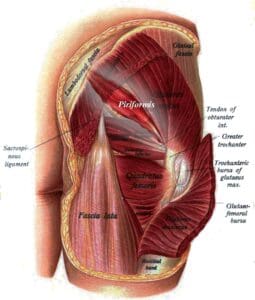Most of us will experience lower back pain at some point in our lives. Maybe it was picking up a kiddo or a small item that brought you back down to the floor. Back pain can range from minor discomfort to debilitating. Common issues with lower back pain can include sciatica, which is the radiating sensation of pain coming from your sciatic nerve. When the sciatic nerve hits the alarm, you’ll know!
What’s the Sciatic Nerve?
It’s the longest nerve in our bodies. The sciatic nerve branches from your lower back through your hips, butt, and all the way down your leg. Generally speaking, when you have back pain, you’ll feel it on one side or the other. It’s our body’s way of telling us that something’s out of whack. It could stem from a minor disc bulge or disc herniation in your lumbar (lower) spine. Bone spurs, stenosis and other issues can cause sciatica in your lower back.
So, back to pain (pardon the pun). Sciatica can range from mild pain to severe. In minor cases, it’ll cause tingling. In more severe cases, it’ll radiate like your butt or leg is on fire, ultimately leading to numbness and potentially even weakness in the leg and the muscles supporting it. We recommend that any time sciatic pain is felt that you seek expert care, preferably with Pro-Care Medical Centers’ chiropractic team… wink, wink.
The Piriformis Muscle
Outside of minor or major disc issues, there’s also a little known muscle in your buttocks that might be contributing to some of your lower back pain: the piriformis muscle! It’s a muscle located deep behind your rump (the gluteus maximus). It’s a small muscle, but a major player in the health of your lower back, glutes, hips, and leg.

The piriformis lets us know when it’s not happy. When it’s irritated, the piriformis can contract to hit you know what: the sciatic nerve. The piriformis can tighten, spasm, and swell due to injury or irritation. Called Piriformis Syndrome, you generally are going to have lower back pain and sciatica when your piriformis isn’t having what you’re having. It can also cause irritation and pain in the sacroiliac joint (aka SI Joint) causing even more lower back pain and in the hip.
Keeping Your Piriformis Happy
It’s best to have our providers exam what’s causing your lower back pain. Often times, SMART Sessions may be the fix as they combine soft tissue work, rehab, and chiropractic adjustments to address the lower back pain. That said, if the pain is minor and manageable, there are some exercises we recommend. Mobility, specifically hip mobility, is key to keeping your piriformis healthy and happy. It’s a tough muscle to get to, but here are three exercises we recommend:
1. Pigeon Stretch
2. Figure 4 Knee to Chest Stretch
3. McKenzie Seated Flexion
Try these exercises or stretches to help you address your lower back pain, stretch that mighty piriformis muscle and start feeling better! If you need more stretches, check out our Video Library with Pro-Care Protocols. Of course, we’d recommend you book an appointment online for chiropractic care in Austin, Cedar Park and San Antonio too!



